Business Law Report: Implied Terms, Agreements, and Practices
VerifiedAdded on 2023/06/10
|18
|4502
|63
Report
AI Summary
This business law report provides a comprehensive overview of several key areas within the legal framework governing business operations. The report begins by examining the legal rules surrounding implied terms in the sale of goods and services, referencing relevant legislation like the Sale of Goods Act 1979 and the Supply of Goods and Services Act 1982, and it discusses the statutory provisions on the transfer of property and possession. It then delves into the remedies available to both buyers and sellers in cases of breach of contract, along with application of the law in specific case studies. The report further explores product liability, focusing on the responsibilities of manufacturers and the legal recourse available to consumers who have suffered damages due to defective products. The report continues by differentiating between secured and unsecured credit agreements, and it also discusses the various types of agents, their rights, duties, and the rules of termination rights and default notices. Finally, the report addresses monopolies and anti-competitive practices legislation in the UK, including prohibitions on price fixing, cartels, and restrictive practices. Overall, the report offers a detailed analysis of these core business law concepts.
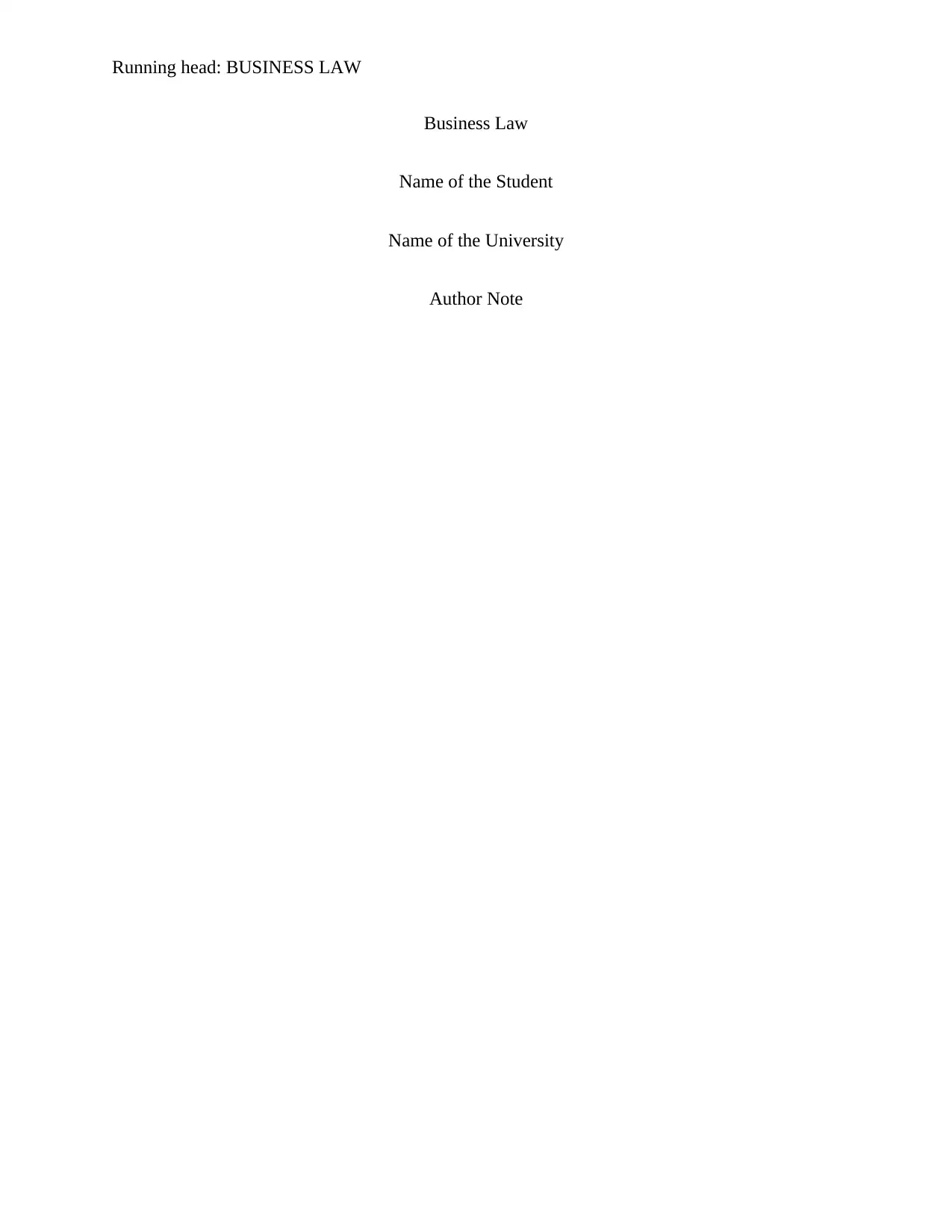
Running head: BUSINESS LAW
Business Law
Name of the Student
Name of the University
Author Note
Business Law
Name of the Student
Name of the University
Author Note
Paraphrase This Document
Need a fresh take? Get an instant paraphrase of this document with our AI Paraphraser
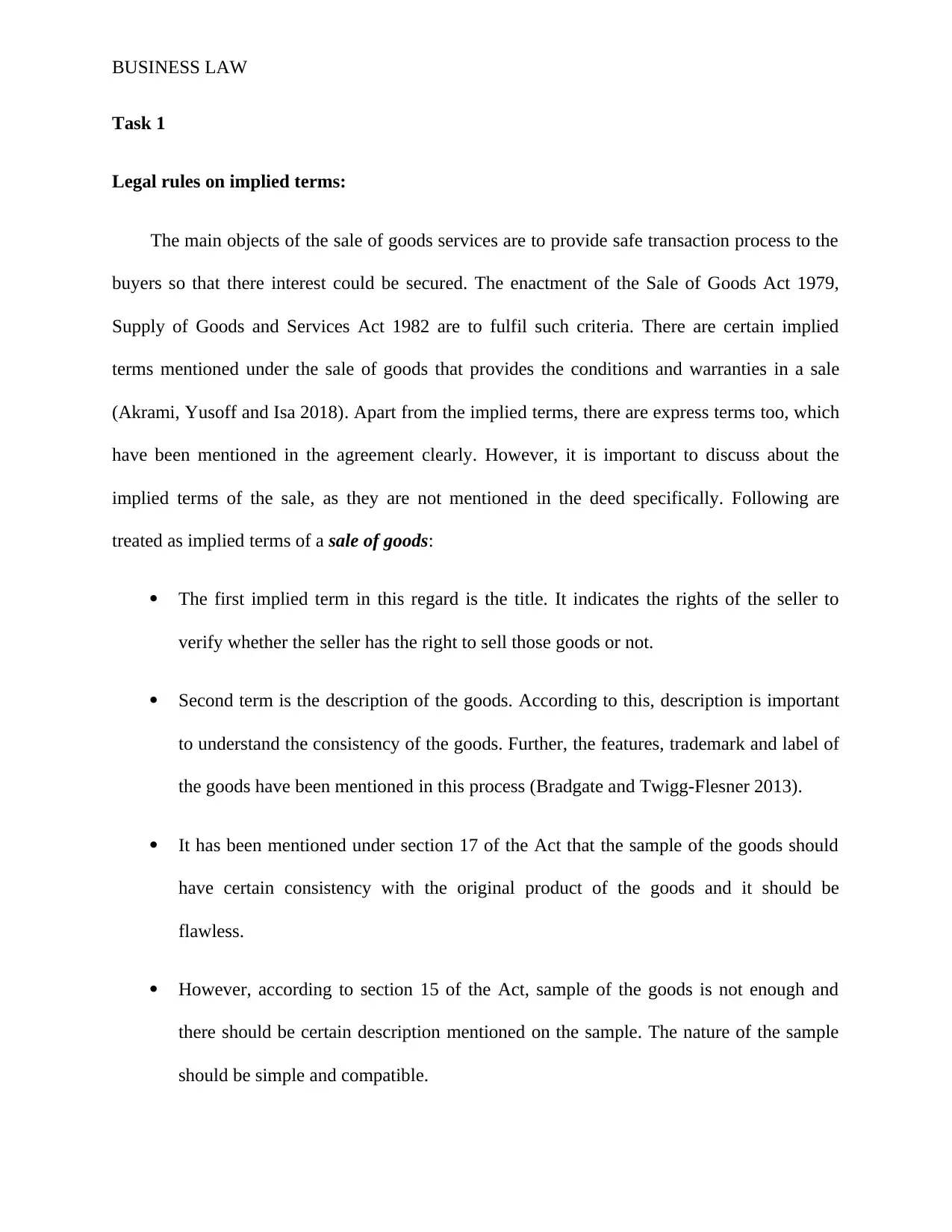
BUSINESS LAW
Task 1
Legal rules on implied terms:
The main objects of the sale of goods services are to provide safe transaction process to the
buyers so that there interest could be secured. The enactment of the Sale of Goods Act 1979,
Supply of Goods and Services Act 1982 are to fulfil such criteria. There are certain implied
terms mentioned under the sale of goods that provides the conditions and warranties in a sale
(Akrami, Yusoff and Isa 2018). Apart from the implied terms, there are express terms too, which
have been mentioned in the agreement clearly. However, it is important to discuss about the
implied terms of the sale, as they are not mentioned in the deed specifically. Following are
treated as implied terms of a sale of goods:
The first implied term in this regard is the title. It indicates the rights of the seller to
verify whether the seller has the right to sell those goods or not.
Second term is the description of the goods. According to this, description is important
to understand the consistency of the goods. Further, the features, trademark and label of
the goods have been mentioned in this process (Bradgate and Twigg-Flesner 2013).
It has been mentioned under section 17 of the Act that the sample of the goods should
have certain consistency with the original product of the goods and it should be
flawless.
However, according to section 15 of the Act, sample of the goods is not enough and
there should be certain description mentioned on the sample. The nature of the sample
should be simple and compatible.
Task 1
Legal rules on implied terms:
The main objects of the sale of goods services are to provide safe transaction process to the
buyers so that there interest could be secured. The enactment of the Sale of Goods Act 1979,
Supply of Goods and Services Act 1982 are to fulfil such criteria. There are certain implied
terms mentioned under the sale of goods that provides the conditions and warranties in a sale
(Akrami, Yusoff and Isa 2018). Apart from the implied terms, there are express terms too, which
have been mentioned in the agreement clearly. However, it is important to discuss about the
implied terms of the sale, as they are not mentioned in the deed specifically. Following are
treated as implied terms of a sale of goods:
The first implied term in this regard is the title. It indicates the rights of the seller to
verify whether the seller has the right to sell those goods or not.
Second term is the description of the goods. According to this, description is important
to understand the consistency of the goods. Further, the features, trademark and label of
the goods have been mentioned in this process (Bradgate and Twigg-Flesner 2013).
It has been mentioned under section 17 of the Act that the sample of the goods should
have certain consistency with the original product of the goods and it should be
flawless.
However, according to section 15 of the Act, sample of the goods is not enough and
there should be certain description mentioned on the sample. The nature of the sample
should be simple and compatible.
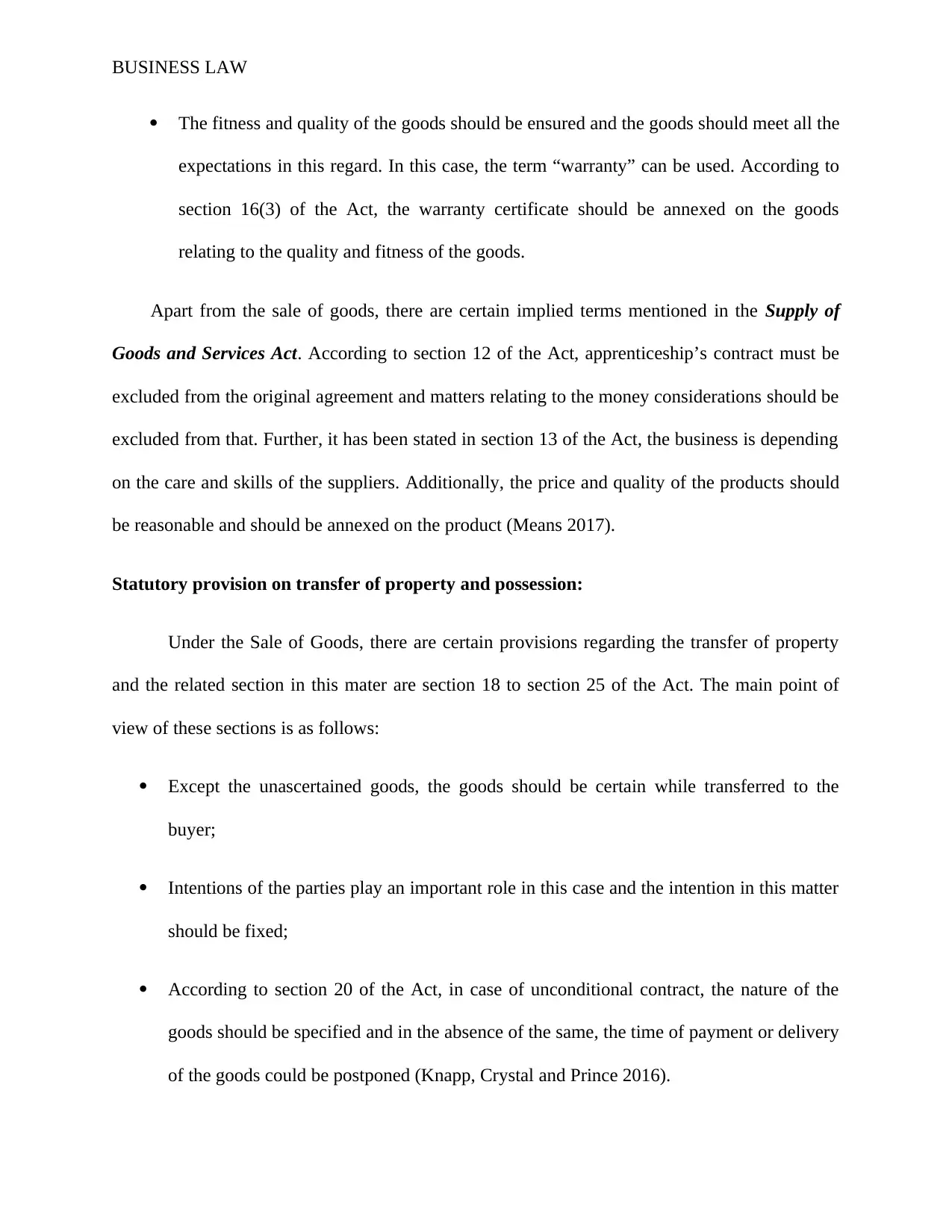
BUSINESS LAW
The fitness and quality of the goods should be ensured and the goods should meet all the
expectations in this regard. In this case, the term “warranty” can be used. According to
section 16(3) of the Act, the warranty certificate should be annexed on the goods
relating to the quality and fitness of the goods.
Apart from the sale of goods, there are certain implied terms mentioned in the Supply of
Goods and Services Act. According to section 12 of the Act, apprenticeship’s contract must be
excluded from the original agreement and matters relating to the money considerations should be
excluded from that. Further, it has been stated in section 13 of the Act, the business is depending
on the care and skills of the suppliers. Additionally, the price and quality of the products should
be reasonable and should be annexed on the product (Means 2017).
Statutory provision on transfer of property and possession:
Under the Sale of Goods, there are certain provisions regarding the transfer of property
and the related section in this mater are section 18 to section 25 of the Act. The main point of
view of these sections is as follows:
Except the unascertained goods, the goods should be certain while transferred to the
buyer;
Intentions of the parties play an important role in this case and the intention in this matter
should be fixed;
According to section 20 of the Act, in case of unconditional contract, the nature of the
goods should be specified and in the absence of the same, the time of payment or delivery
of the goods could be postponed (Knapp, Crystal and Prince 2016).
The fitness and quality of the goods should be ensured and the goods should meet all the
expectations in this regard. In this case, the term “warranty” can be used. According to
section 16(3) of the Act, the warranty certificate should be annexed on the goods
relating to the quality and fitness of the goods.
Apart from the sale of goods, there are certain implied terms mentioned in the Supply of
Goods and Services Act. According to section 12 of the Act, apprenticeship’s contract must be
excluded from the original agreement and matters relating to the money considerations should be
excluded from that. Further, it has been stated in section 13 of the Act, the business is depending
on the care and skills of the suppliers. Additionally, the price and quality of the products should
be reasonable and should be annexed on the product (Means 2017).
Statutory provision on transfer of property and possession:
Under the Sale of Goods, there are certain provisions regarding the transfer of property
and the related section in this mater are section 18 to section 25 of the Act. The main point of
view of these sections is as follows:
Except the unascertained goods, the goods should be certain while transferred to the
buyer;
Intentions of the parties play an important role in this case and the intention in this matter
should be fixed;
According to section 20 of the Act, in case of unconditional contract, the nature of the
goods should be specified and in the absence of the same, the time of payment or delivery
of the goods could be postponed (Knapp, Crystal and Prince 2016).
⊘ This is a preview!⊘
Do you want full access?
Subscribe today to unlock all pages.

Trusted by 1+ million students worldwide
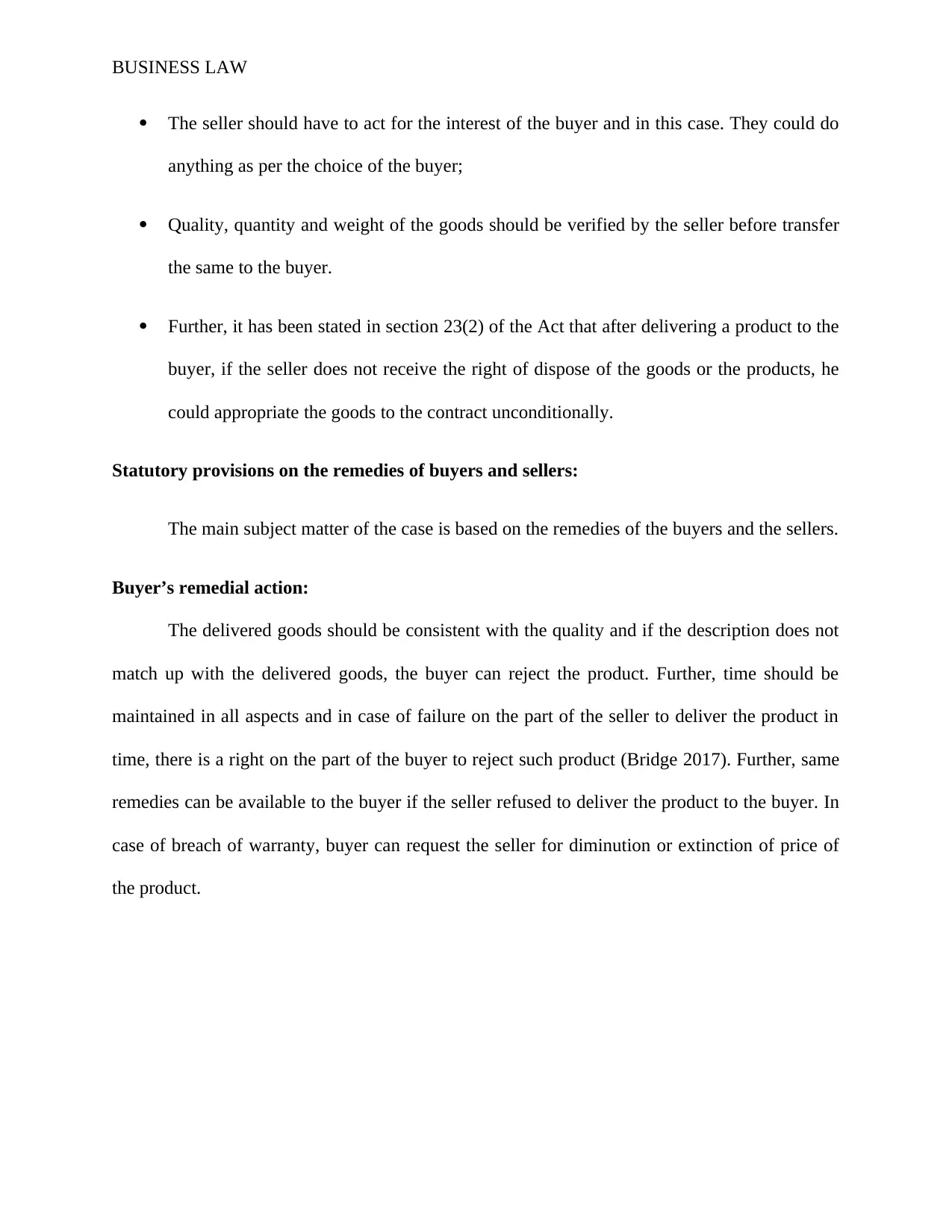
BUSINESS LAW
The seller should have to act for the interest of the buyer and in this case. They could do
anything as per the choice of the buyer;
Quality, quantity and weight of the goods should be verified by the seller before transfer
the same to the buyer.
Further, it has been stated in section 23(2) of the Act that after delivering a product to the
buyer, if the seller does not receive the right of dispose of the goods or the products, he
could appropriate the goods to the contract unconditionally.
Statutory provisions on the remedies of buyers and sellers:
The main subject matter of the case is based on the remedies of the buyers and the sellers.
Buyer’s remedial action:
The delivered goods should be consistent with the quality and if the description does not
match up with the delivered goods, the buyer can reject the product. Further, time should be
maintained in all aspects and in case of failure on the part of the seller to deliver the product in
time, there is a right on the part of the buyer to reject such product (Bridge 2017). Further, same
remedies can be available to the buyer if the seller refused to deliver the product to the buyer. In
case of breach of warranty, buyer can request the seller for diminution or extinction of price of
the product.
The seller should have to act for the interest of the buyer and in this case. They could do
anything as per the choice of the buyer;
Quality, quantity and weight of the goods should be verified by the seller before transfer
the same to the buyer.
Further, it has been stated in section 23(2) of the Act that after delivering a product to the
buyer, if the seller does not receive the right of dispose of the goods or the products, he
could appropriate the goods to the contract unconditionally.
Statutory provisions on the remedies of buyers and sellers:
The main subject matter of the case is based on the remedies of the buyers and the sellers.
Buyer’s remedial action:
The delivered goods should be consistent with the quality and if the description does not
match up with the delivered goods, the buyer can reject the product. Further, time should be
maintained in all aspects and in case of failure on the part of the seller to deliver the product in
time, there is a right on the part of the buyer to reject such product (Bridge 2017). Further, same
remedies can be available to the buyer if the seller refused to deliver the product to the buyer. In
case of breach of warranty, buyer can request the seller for diminution or extinction of price of
the product.
Paraphrase This Document
Need a fresh take? Get an instant paraphrase of this document with our AI Paraphraser
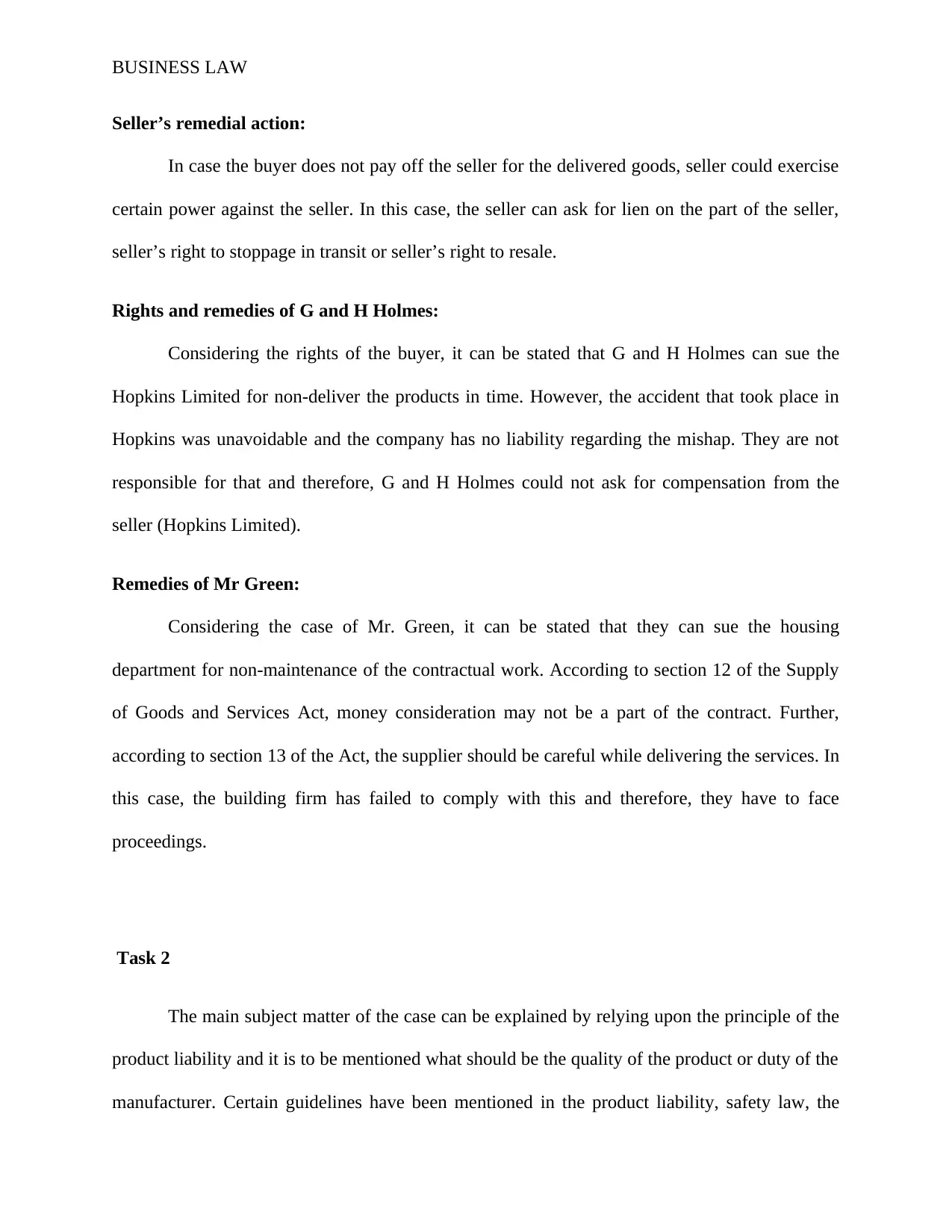
BUSINESS LAW
Seller’s remedial action:
In case the buyer does not pay off the seller for the delivered goods, seller could exercise
certain power against the seller. In this case, the seller can ask for lien on the part of the seller,
seller’s right to stoppage in transit or seller’s right to resale.
Rights and remedies of G and H Holmes:
Considering the rights of the buyer, it can be stated that G and H Holmes can sue the
Hopkins Limited for non-deliver the products in time. However, the accident that took place in
Hopkins was unavoidable and the company has no liability regarding the mishap. They are not
responsible for that and therefore, G and H Holmes could not ask for compensation from the
seller (Hopkins Limited).
Remedies of Mr Green:
Considering the case of Mr. Green, it can be stated that they can sue the housing
department for non-maintenance of the contractual work. According to section 12 of the Supply
of Goods and Services Act, money consideration may not be a part of the contract. Further,
according to section 13 of the Act, the supplier should be careful while delivering the services. In
this case, the building firm has failed to comply with this and therefore, they have to face
proceedings.
Task 2
The main subject matter of the case can be explained by relying upon the principle of the
product liability and it is to be mentioned what should be the quality of the product or duty of the
manufacturer. Certain guidelines have been mentioned in the product liability, safety law, the
Seller’s remedial action:
In case the buyer does not pay off the seller for the delivered goods, seller could exercise
certain power against the seller. In this case, the seller can ask for lien on the part of the seller,
seller’s right to stoppage in transit or seller’s right to resale.
Rights and remedies of G and H Holmes:
Considering the rights of the buyer, it can be stated that G and H Holmes can sue the
Hopkins Limited for non-deliver the products in time. However, the accident that took place in
Hopkins was unavoidable and the company has no liability regarding the mishap. They are not
responsible for that and therefore, G and H Holmes could not ask for compensation from the
seller (Hopkins Limited).
Remedies of Mr Green:
Considering the case of Mr. Green, it can be stated that they can sue the housing
department for non-maintenance of the contractual work. According to section 12 of the Supply
of Goods and Services Act, money consideration may not be a part of the contract. Further,
according to section 13 of the Act, the supplier should be careful while delivering the services. In
this case, the building firm has failed to comply with this and therefore, they have to face
proceedings.
Task 2
The main subject matter of the case can be explained by relying upon the principle of the
product liability and it is to be mentioned what should be the quality of the product or duty of the
manufacturer. Certain guidelines have been mentioned in the product liability, safety law, the
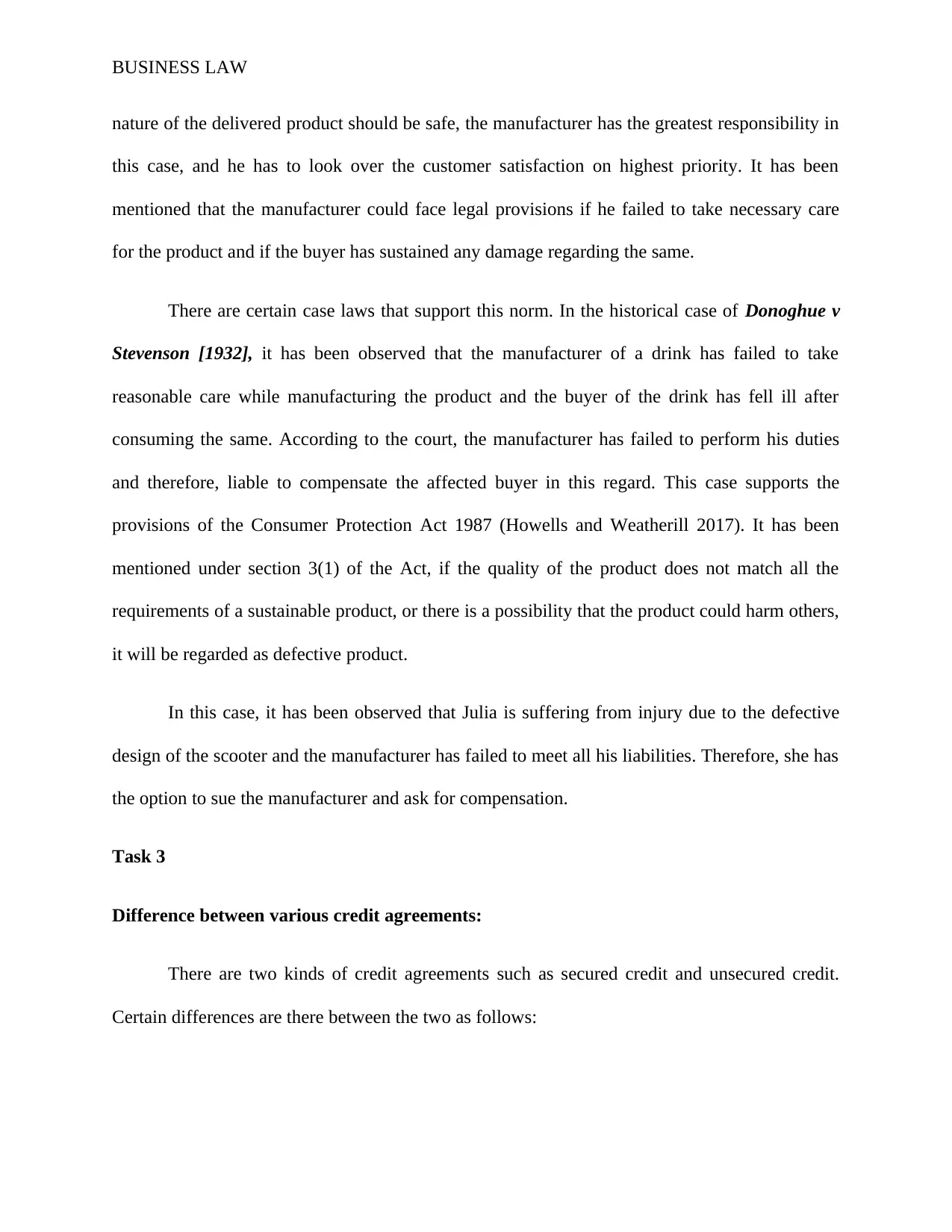
BUSINESS LAW
nature of the delivered product should be safe, the manufacturer has the greatest responsibility in
this case, and he has to look over the customer satisfaction on highest priority. It has been
mentioned that the manufacturer could face legal provisions if he failed to take necessary care
for the product and if the buyer has sustained any damage regarding the same.
There are certain case laws that support this norm. In the historical case of Donoghue v
Stevenson [1932], it has been observed that the manufacturer of a drink has failed to take
reasonable care while manufacturing the product and the buyer of the drink has fell ill after
consuming the same. According to the court, the manufacturer has failed to perform his duties
and therefore, liable to compensate the affected buyer in this regard. This case supports the
provisions of the Consumer Protection Act 1987 (Howells and Weatherill 2017). It has been
mentioned under section 3(1) of the Act, if the quality of the product does not match all the
requirements of a sustainable product, or there is a possibility that the product could harm others,
it will be regarded as defective product.
In this case, it has been observed that Julia is suffering from injury due to the defective
design of the scooter and the manufacturer has failed to meet all his liabilities. Therefore, she has
the option to sue the manufacturer and ask for compensation.
Task 3
Difference between various credit agreements:
There are two kinds of credit agreements such as secured credit and unsecured credit.
Certain differences are there between the two as follows:
nature of the delivered product should be safe, the manufacturer has the greatest responsibility in
this case, and he has to look over the customer satisfaction on highest priority. It has been
mentioned that the manufacturer could face legal provisions if he failed to take necessary care
for the product and if the buyer has sustained any damage regarding the same.
There are certain case laws that support this norm. In the historical case of Donoghue v
Stevenson [1932], it has been observed that the manufacturer of a drink has failed to take
reasonable care while manufacturing the product and the buyer of the drink has fell ill after
consuming the same. According to the court, the manufacturer has failed to perform his duties
and therefore, liable to compensate the affected buyer in this regard. This case supports the
provisions of the Consumer Protection Act 1987 (Howells and Weatherill 2017). It has been
mentioned under section 3(1) of the Act, if the quality of the product does not match all the
requirements of a sustainable product, or there is a possibility that the product could harm others,
it will be regarded as defective product.
In this case, it has been observed that Julia is suffering from injury due to the defective
design of the scooter and the manufacturer has failed to meet all his liabilities. Therefore, she has
the option to sue the manufacturer and ask for compensation.
Task 3
Difference between various credit agreements:
There are two kinds of credit agreements such as secured credit and unsecured credit.
Certain differences are there between the two as follows:
⊘ This is a preview!⊘
Do you want full access?
Subscribe today to unlock all pages.

Trusted by 1+ million students worldwide
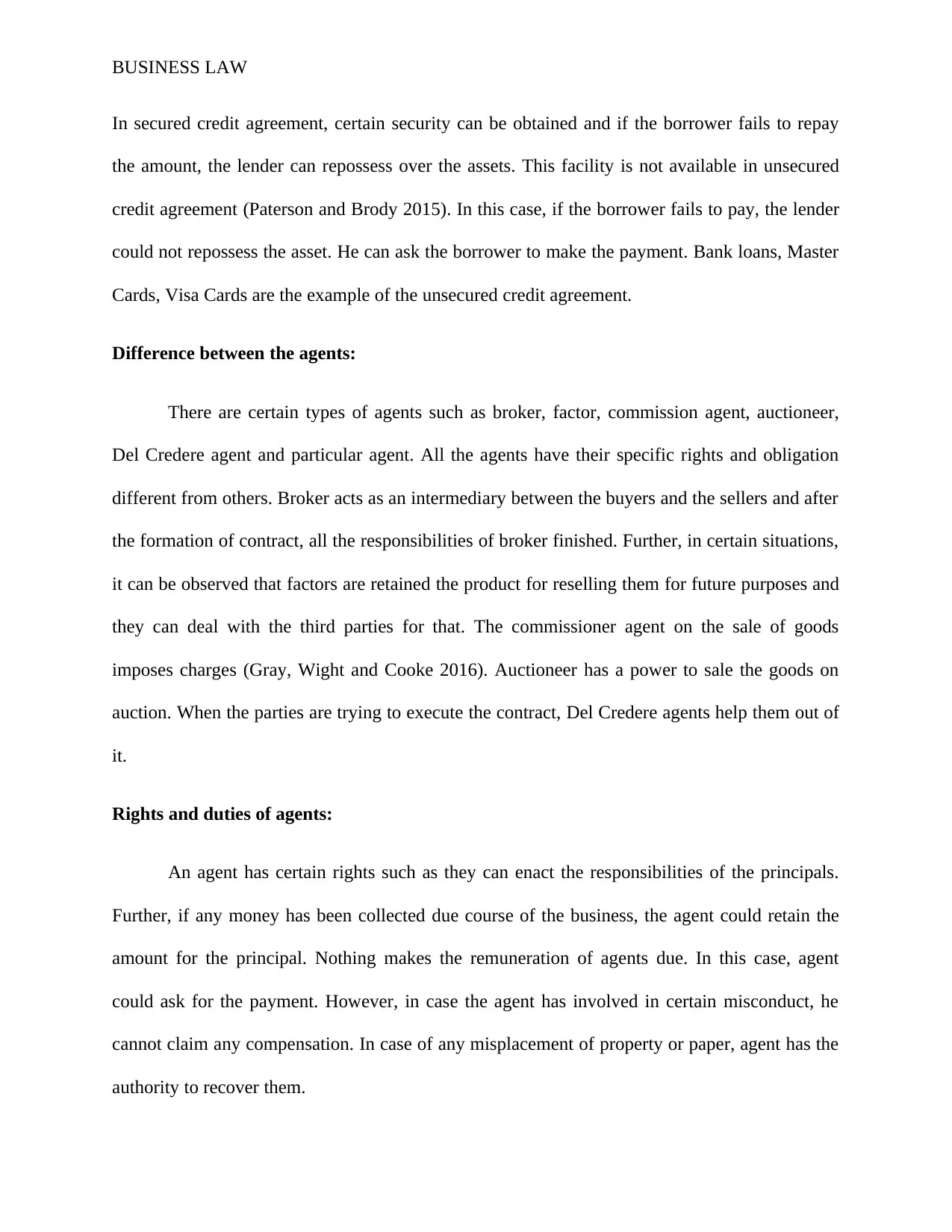
BUSINESS LAW
In secured credit agreement, certain security can be obtained and if the borrower fails to repay
the amount, the lender can repossess over the assets. This facility is not available in unsecured
credit agreement (Paterson and Brody 2015). In this case, if the borrower fails to pay, the lender
could not repossess the asset. He can ask the borrower to make the payment. Bank loans, Master
Cards, Visa Cards are the example of the unsecured credit agreement.
Difference between the agents:
There are certain types of agents such as broker, factor, commission agent, auctioneer,
Del Credere agent and particular agent. All the agents have their specific rights and obligation
different from others. Broker acts as an intermediary between the buyers and the sellers and after
the formation of contract, all the responsibilities of broker finished. Further, in certain situations,
it can be observed that factors are retained the product for reselling them for future purposes and
they can deal with the third parties for that. The commissioner agent on the sale of goods
imposes charges (Gray, Wight and Cooke 2016). Auctioneer has a power to sale the goods on
auction. When the parties are trying to execute the contract, Del Credere agents help them out of
it.
Rights and duties of agents:
An agent has certain rights such as they can enact the responsibilities of the principals.
Further, if any money has been collected due course of the business, the agent could retain the
amount for the principal. Nothing makes the remuneration of agents due. In this case, agent
could ask for the payment. However, in case the agent has involved in certain misconduct, he
cannot claim any compensation. In case of any misplacement of property or paper, agent has the
authority to recover them.
In secured credit agreement, certain security can be obtained and if the borrower fails to repay
the amount, the lender can repossess over the assets. This facility is not available in unsecured
credit agreement (Paterson and Brody 2015). In this case, if the borrower fails to pay, the lender
could not repossess the asset. He can ask the borrower to make the payment. Bank loans, Master
Cards, Visa Cards are the example of the unsecured credit agreement.
Difference between the agents:
There are certain types of agents such as broker, factor, commission agent, auctioneer,
Del Credere agent and particular agent. All the agents have their specific rights and obligation
different from others. Broker acts as an intermediary between the buyers and the sellers and after
the formation of contract, all the responsibilities of broker finished. Further, in certain situations,
it can be observed that factors are retained the product for reselling them for future purposes and
they can deal with the third parties for that. The commissioner agent on the sale of goods
imposes charges (Gray, Wight and Cooke 2016). Auctioneer has a power to sale the goods on
auction. When the parties are trying to execute the contract, Del Credere agents help them out of
it.
Rights and duties of agents:
An agent has certain rights such as they can enact the responsibilities of the principals.
Further, if any money has been collected due course of the business, the agent could retain the
amount for the principal. Nothing makes the remuneration of agents due. In this case, agent
could ask for the payment. However, in case the agent has involved in certain misconduct, he
cannot claim any compensation. In case of any misplacement of property or paper, agent has the
authority to recover them.
Paraphrase This Document
Need a fresh take? Get an instant paraphrase of this document with our AI Paraphraser
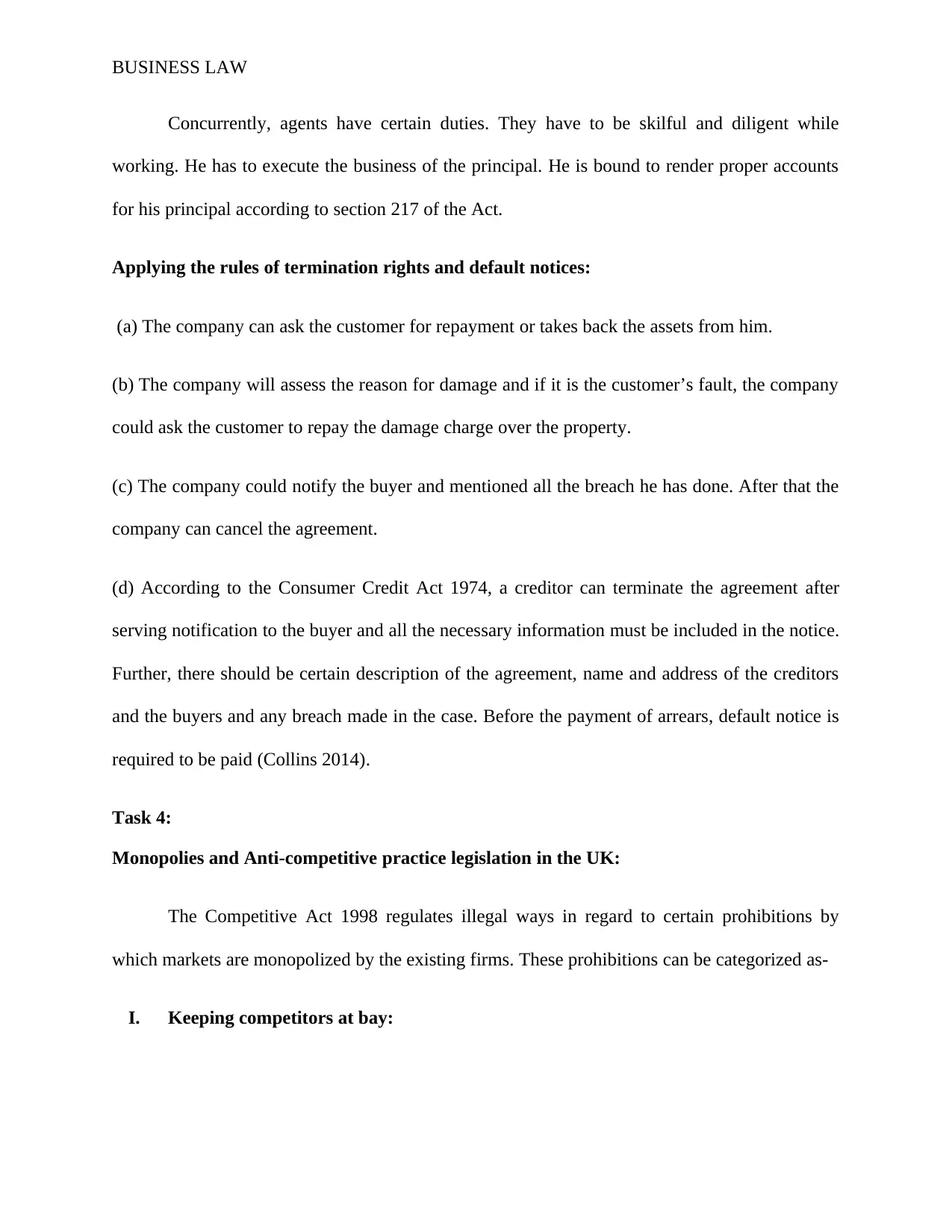
BUSINESS LAW
Concurrently, agents have certain duties. They have to be skilful and diligent while
working. He has to execute the business of the principal. He is bound to render proper accounts
for his principal according to section 217 of the Act.
Applying the rules of termination rights and default notices:
(a) The company can ask the customer for repayment or takes back the assets from him.
(b) The company will assess the reason for damage and if it is the customer’s fault, the company
could ask the customer to repay the damage charge over the property.
(c) The company could notify the buyer and mentioned all the breach he has done. After that the
company can cancel the agreement.
(d) According to the Consumer Credit Act 1974, a creditor can terminate the agreement after
serving notification to the buyer and all the necessary information must be included in the notice.
Further, there should be certain description of the agreement, name and address of the creditors
and the buyers and any breach made in the case. Before the payment of arrears, default notice is
required to be paid (Collins 2014).
Task 4:
Monopolies and Anti-competitive practice legislation in the UK:
The Competitive Act 1998 regulates illegal ways in regard to certain prohibitions by
which markets are monopolized by the existing firms. These prohibitions can be categorized as-
I. Keeping competitors at bay:
Concurrently, agents have certain duties. They have to be skilful and diligent while
working. He has to execute the business of the principal. He is bound to render proper accounts
for his principal according to section 217 of the Act.
Applying the rules of termination rights and default notices:
(a) The company can ask the customer for repayment or takes back the assets from him.
(b) The company will assess the reason for damage and if it is the customer’s fault, the company
could ask the customer to repay the damage charge over the property.
(c) The company could notify the buyer and mentioned all the breach he has done. After that the
company can cancel the agreement.
(d) According to the Consumer Credit Act 1974, a creditor can terminate the agreement after
serving notification to the buyer and all the necessary information must be included in the notice.
Further, there should be certain description of the agreement, name and address of the creditors
and the buyers and any breach made in the case. Before the payment of arrears, default notice is
required to be paid (Collins 2014).
Task 4:
Monopolies and Anti-competitive practice legislation in the UK:
The Competitive Act 1998 regulates illegal ways in regard to certain prohibitions by
which markets are monopolized by the existing firms. These prohibitions can be categorized as-
I. Keeping competitors at bay:
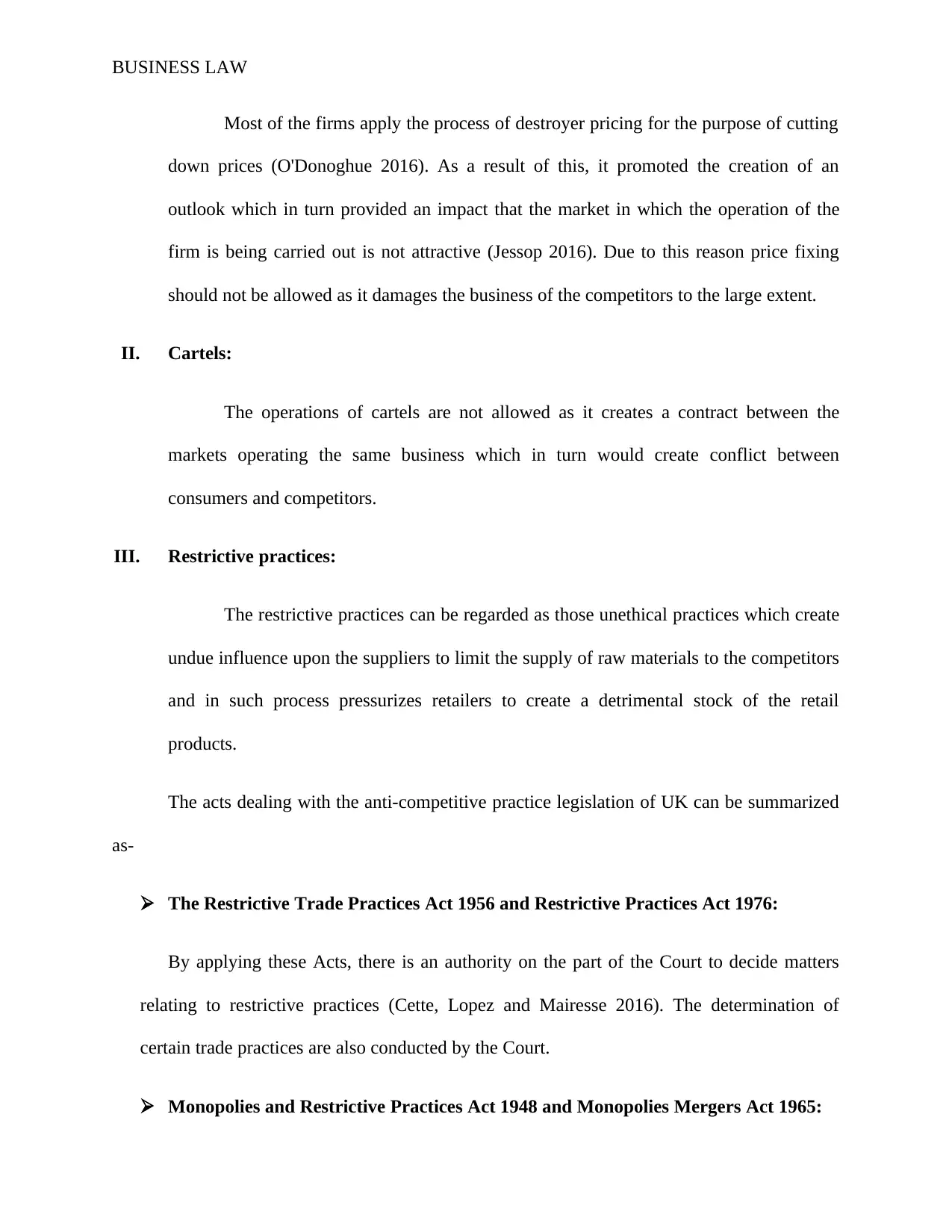
BUSINESS LAW
Most of the firms apply the process of destroyer pricing for the purpose of cutting
down prices (O'Donoghue 2016). As a result of this, it promoted the creation of an
outlook which in turn provided an impact that the market in which the operation of the
firm is being carried out is not attractive (Jessop 2016). Due to this reason price fixing
should not be allowed as it damages the business of the competitors to the large extent.
II. Cartels:
The operations of cartels are not allowed as it creates a contract between the
markets operating the same business which in turn would create conflict between
consumers and competitors.
III. Restrictive practices:
The restrictive practices can be regarded as those unethical practices which create
undue influence upon the suppliers to limit the supply of raw materials to the competitors
and in such process pressurizes retailers to create a detrimental stock of the retail
products.
The acts dealing with the anti-competitive practice legislation of UK can be summarized
as-
The Restrictive Trade Practices Act 1956 and Restrictive Practices Act 1976:
By applying these Acts, there is an authority on the part of the Court to decide matters
relating to restrictive practices (Cette, Lopez and Mairesse 2016). The determination of
certain trade practices are also conducted by the Court.
Monopolies and Restrictive Practices Act 1948 and Monopolies Mergers Act 1965:
Most of the firms apply the process of destroyer pricing for the purpose of cutting
down prices (O'Donoghue 2016). As a result of this, it promoted the creation of an
outlook which in turn provided an impact that the market in which the operation of the
firm is being carried out is not attractive (Jessop 2016). Due to this reason price fixing
should not be allowed as it damages the business of the competitors to the large extent.
II. Cartels:
The operations of cartels are not allowed as it creates a contract between the
markets operating the same business which in turn would create conflict between
consumers and competitors.
III. Restrictive practices:
The restrictive practices can be regarded as those unethical practices which create
undue influence upon the suppliers to limit the supply of raw materials to the competitors
and in such process pressurizes retailers to create a detrimental stock of the retail
products.
The acts dealing with the anti-competitive practice legislation of UK can be summarized
as-
The Restrictive Trade Practices Act 1956 and Restrictive Practices Act 1976:
By applying these Acts, there is an authority on the part of the Court to decide matters
relating to restrictive practices (Cette, Lopez and Mairesse 2016). The determination of
certain trade practices are also conducted by the Court.
Monopolies and Restrictive Practices Act 1948 and Monopolies Mergers Act 1965:
⊘ This is a preview!⊘
Do you want full access?
Subscribe today to unlock all pages.

Trusted by 1+ million students worldwide
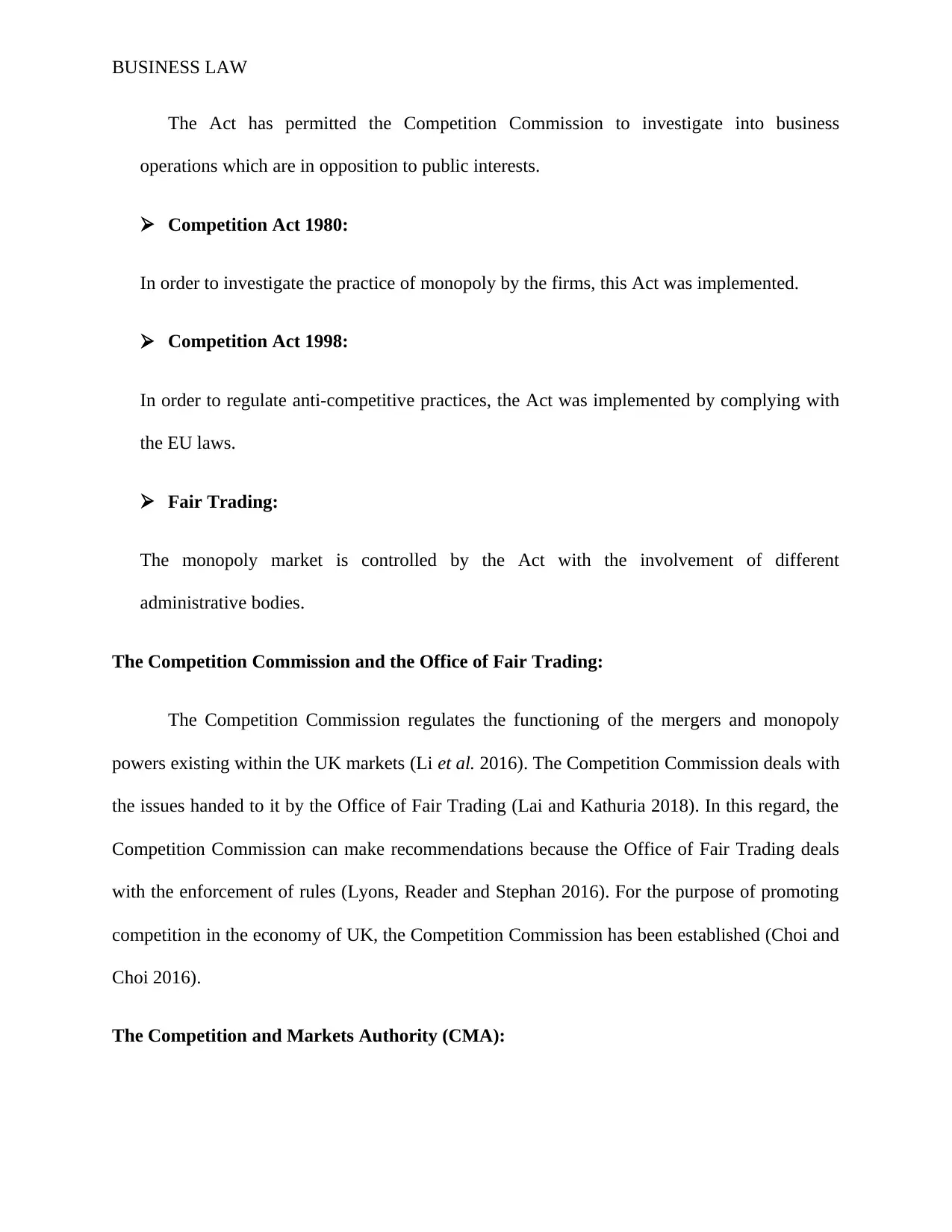
BUSINESS LAW
The Act has permitted the Competition Commission to investigate into business
operations which are in opposition to public interests.
Competition Act 1980:
In order to investigate the practice of monopoly by the firms, this Act was implemented.
Competition Act 1998:
In order to regulate anti-competitive practices, the Act was implemented by complying with
the EU laws.
Fair Trading:
The monopoly market is controlled by the Act with the involvement of different
administrative bodies.
The Competition Commission and the Office of Fair Trading:
The Competition Commission regulates the functioning of the mergers and monopoly
powers existing within the UK markets (Li et al. 2016). The Competition Commission deals with
the issues handed to it by the Office of Fair Trading (Lai and Kathuria 2018). In this regard, the
Competition Commission can make recommendations because the Office of Fair Trading deals
with the enforcement of rules (Lyons, Reader and Stephan 2016). For the purpose of promoting
competition in the economy of UK, the Competition Commission has been established (Choi and
Choi 2016).
The Competition and Markets Authority (CMA):
The Act has permitted the Competition Commission to investigate into business
operations which are in opposition to public interests.
Competition Act 1980:
In order to investigate the practice of monopoly by the firms, this Act was implemented.
Competition Act 1998:
In order to regulate anti-competitive practices, the Act was implemented by complying with
the EU laws.
Fair Trading:
The monopoly market is controlled by the Act with the involvement of different
administrative bodies.
The Competition Commission and the Office of Fair Trading:
The Competition Commission regulates the functioning of the mergers and monopoly
powers existing within the UK markets (Li et al. 2016). The Competition Commission deals with
the issues handed to it by the Office of Fair Trading (Lai and Kathuria 2018). In this regard, the
Competition Commission can make recommendations because the Office of Fair Trading deals
with the enforcement of rules (Lyons, Reader and Stephan 2016). For the purpose of promoting
competition in the economy of UK, the Competition Commission has been established (Choi and
Choi 2016).
The Competition and Markets Authority (CMA):
Paraphrase This Document
Need a fresh take? Get an instant paraphrase of this document with our AI Paraphraser
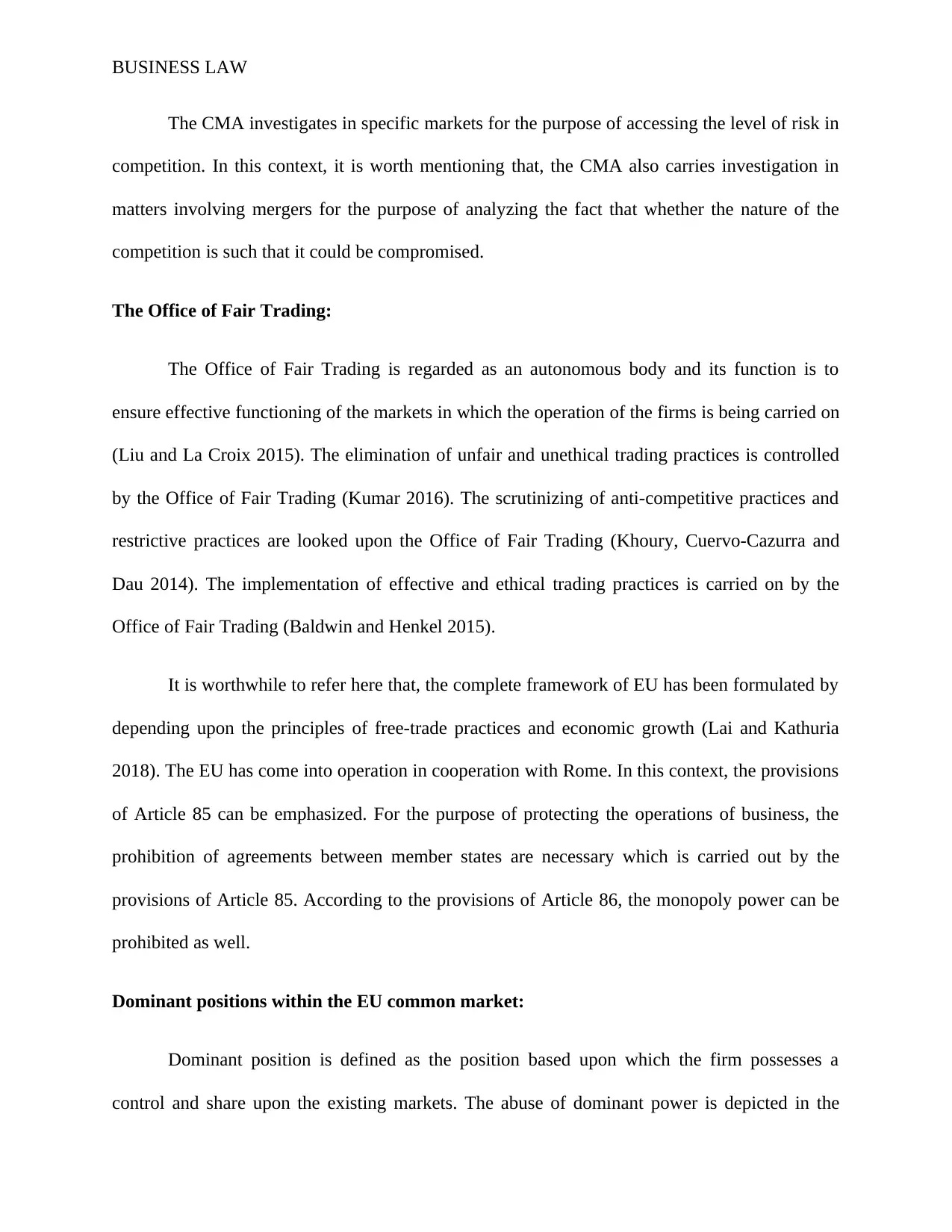
BUSINESS LAW
The CMA investigates in specific markets for the purpose of accessing the level of risk in
competition. In this context, it is worth mentioning that, the CMA also carries investigation in
matters involving mergers for the purpose of analyzing the fact that whether the nature of the
competition is such that it could be compromised.
The Office of Fair Trading:
The Office of Fair Trading is regarded as an autonomous body and its function is to
ensure effective functioning of the markets in which the operation of the firms is being carried on
(Liu and La Croix 2015). The elimination of unfair and unethical trading practices is controlled
by the Office of Fair Trading (Kumar 2016). The scrutinizing of anti-competitive practices and
restrictive practices are looked upon the Office of Fair Trading (Khoury, Cuervo‐Cazurra and
Dau 2014). The implementation of effective and ethical trading practices is carried on by the
Office of Fair Trading (Baldwin and Henkel 2015).
It is worthwhile to refer here that, the complete framework of EU has been formulated by
depending upon the principles of free-trade practices and economic growth (Lai and Kathuria
2018). The EU has come into operation in cooperation with Rome. In this context, the provisions
of Article 85 can be emphasized. For the purpose of protecting the operations of business, the
prohibition of agreements between member states are necessary which is carried out by the
provisions of Article 85. According to the provisions of Article 86, the monopoly power can be
prohibited as well.
Dominant positions within the EU common market:
Dominant position is defined as the position based upon which the firm possesses a
control and share upon the existing markets. The abuse of dominant power is depicted in the
The CMA investigates in specific markets for the purpose of accessing the level of risk in
competition. In this context, it is worth mentioning that, the CMA also carries investigation in
matters involving mergers for the purpose of analyzing the fact that whether the nature of the
competition is such that it could be compromised.
The Office of Fair Trading:
The Office of Fair Trading is regarded as an autonomous body and its function is to
ensure effective functioning of the markets in which the operation of the firms is being carried on
(Liu and La Croix 2015). The elimination of unfair and unethical trading practices is controlled
by the Office of Fair Trading (Kumar 2016). The scrutinizing of anti-competitive practices and
restrictive practices are looked upon the Office of Fair Trading (Khoury, Cuervo‐Cazurra and
Dau 2014). The implementation of effective and ethical trading practices is carried on by the
Office of Fair Trading (Baldwin and Henkel 2015).
It is worthwhile to refer here that, the complete framework of EU has been formulated by
depending upon the principles of free-trade practices and economic growth (Lai and Kathuria
2018). The EU has come into operation in cooperation with Rome. In this context, the provisions
of Article 85 can be emphasized. For the purpose of protecting the operations of business, the
prohibition of agreements between member states are necessary which is carried out by the
provisions of Article 85. According to the provisions of Article 86, the monopoly power can be
prohibited as well.
Dominant positions within the EU common market:
Dominant position is defined as the position based upon which the firm possesses a
control and share upon the existing markets. The abuse of dominant power is depicted in the
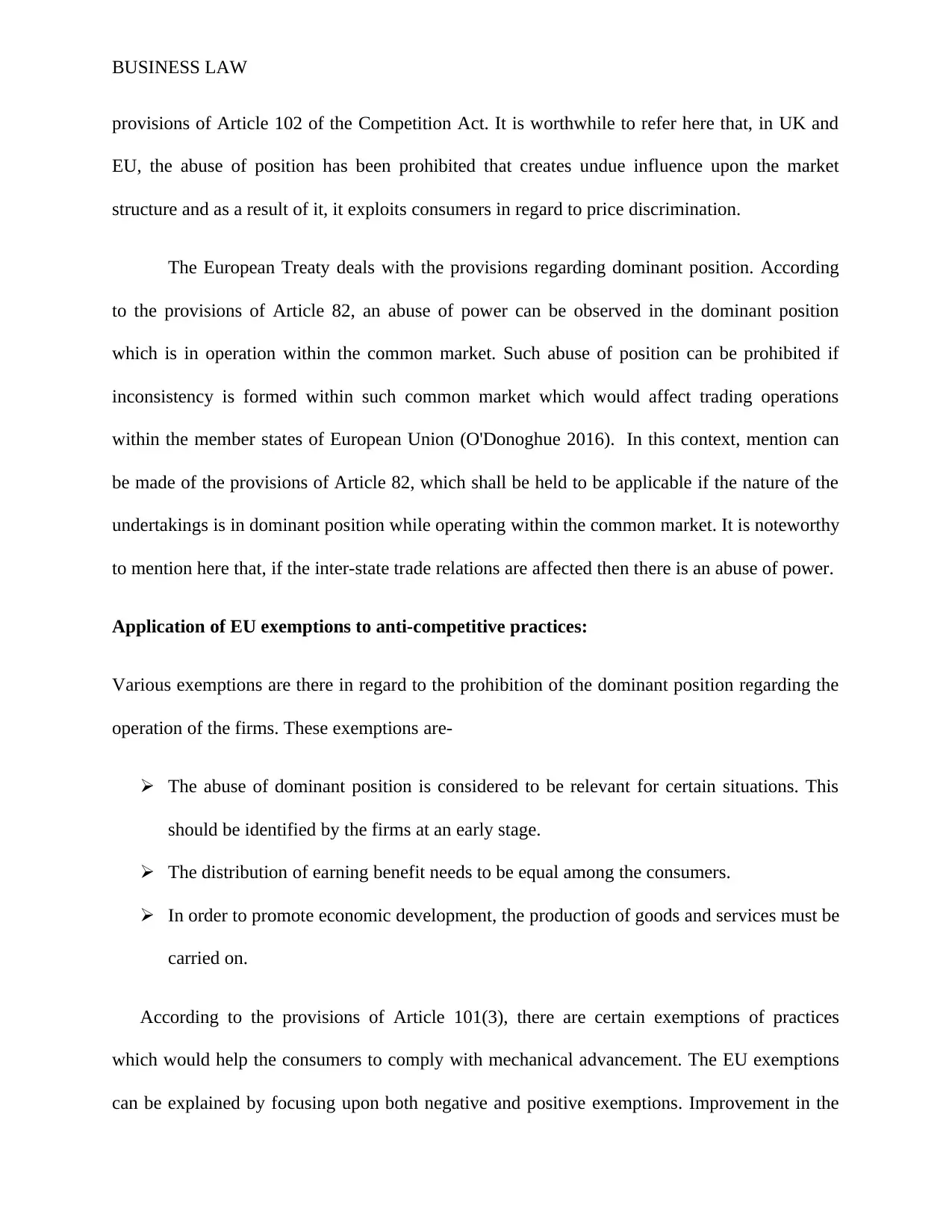
BUSINESS LAW
provisions of Article 102 of the Competition Act. It is worthwhile to refer here that, in UK and
EU, the abuse of position has been prohibited that creates undue influence upon the market
structure and as a result of it, it exploits consumers in regard to price discrimination.
The European Treaty deals with the provisions regarding dominant position. According
to the provisions of Article 82, an abuse of power can be observed in the dominant position
which is in operation within the common market. Such abuse of position can be prohibited if
inconsistency is formed within such common market which would affect trading operations
within the member states of European Union (O'Donoghue 2016). In this context, mention can
be made of the provisions of Article 82, which shall be held to be applicable if the nature of the
undertakings is in dominant position while operating within the common market. It is noteworthy
to mention here that, if the inter-state trade relations are affected then there is an abuse of power.
Application of EU exemptions to anti-competitive practices:
Various exemptions are there in regard to the prohibition of the dominant position regarding the
operation of the firms. These exemptions are-
The abuse of dominant position is considered to be relevant for certain situations. This
should be identified by the firms at an early stage.
The distribution of earning benefit needs to be equal among the consumers.
In order to promote economic development, the production of goods and services must be
carried on.
According to the provisions of Article 101(3), there are certain exemptions of practices
which would help the consumers to comply with mechanical advancement. The EU exemptions
can be explained by focusing upon both negative and positive exemptions. Improvement in the
provisions of Article 102 of the Competition Act. It is worthwhile to refer here that, in UK and
EU, the abuse of position has been prohibited that creates undue influence upon the market
structure and as a result of it, it exploits consumers in regard to price discrimination.
The European Treaty deals with the provisions regarding dominant position. According
to the provisions of Article 82, an abuse of power can be observed in the dominant position
which is in operation within the common market. Such abuse of position can be prohibited if
inconsistency is formed within such common market which would affect trading operations
within the member states of European Union (O'Donoghue 2016). In this context, mention can
be made of the provisions of Article 82, which shall be held to be applicable if the nature of the
undertakings is in dominant position while operating within the common market. It is noteworthy
to mention here that, if the inter-state trade relations are affected then there is an abuse of power.
Application of EU exemptions to anti-competitive practices:
Various exemptions are there in regard to the prohibition of the dominant position regarding the
operation of the firms. These exemptions are-
The abuse of dominant position is considered to be relevant for certain situations. This
should be identified by the firms at an early stage.
The distribution of earning benefit needs to be equal among the consumers.
In order to promote economic development, the production of goods and services must be
carried on.
According to the provisions of Article 101(3), there are certain exemptions of practices
which would help the consumers to comply with mechanical advancement. The EU exemptions
can be explained by focusing upon both negative and positive exemptions. Improvement in the
⊘ This is a preview!⊘
Do you want full access?
Subscribe today to unlock all pages.

Trusted by 1+ million students worldwide
1 out of 18
Related Documents
Your All-in-One AI-Powered Toolkit for Academic Success.
+13062052269
info@desklib.com
Available 24*7 on WhatsApp / Email
![[object Object]](/_next/static/media/star-bottom.7253800d.svg)
Unlock your academic potential
Copyright © 2020–2025 A2Z Services. All Rights Reserved. Developed and managed by ZUCOL.




